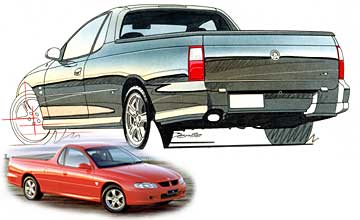BY TIM BRITTEN | 11th Jul 2001

The slightly downmarket S V6 version of the new ute looks pretty neat too, even though it lacks the 17-inch wheels and body add-ons of the rorty, top-spec 5.7-litre V8.
Only differentiated from the base ute by the (16-inch) alloy wheels and the odd dab of body-colour instead of matt grey, the S ute is nevertheless a cool customer. It's better at taking on a general multi-purpose role than the blatant SS because it's got a more absorbent suspension and a more high-riding, underside-saving stance.
The S also comes with the workhorse 3.8-litre V6 that does duty across the Commodore range, plus the choice of five-speed manual or four-speed automatic transmission. Because the ute is lighter than the Commodore sedan, this means a quite reasonable turn of speed. And because of the fully independent rear suspension, there's also the fact that it is less skittish on so-so road surfaces than traditional expectations.
The VU ute comes across as a stylish semi-workhorse that's been to finishing school. There are few rough edges and the claim by Holden that the experience of driving the ute is little different to driving a Commodore sedan proves pretty realistic.
In practical terms it carries a greater payload than the VS could (up by 18 per cent in the base model) in a wider, longer tray made useful by the extensive application of galvanised steel and by the availability of a full polypropylene cargo liner that minimises the risk of scrapes and dents.
The interior is bigger than VS, too, although it doesn't have the usefulness of Falcon's large behind-seat storage area (it does offer fairly decent space here though). Leg, shoulder and headroom are better than before, and there is more seat travel to cater for a varying range of physiques.
Presentation is essentially the same as VX Commodore sedans with soft seat trim and fabric inserts on the doors to give a warm, cosy feel. The seats are big, supportive and, in the S, fitted with power adjustment for height and backrest rake angle on the driver's side. Not so for the passenger, although adjustable lumbar support is provided.
The passenger also misses out on an airbag, and air-conditioning is optional, although at least there is a six-function trip computer and a CD player, as well as power windows and steering wheel controls for the audio and cruise control.
At around $9000 less than the SS, it's understandable that the S ute doesn't have anti-lock brakes but it does get a limited-slip differential and the soft tonneau cover missing on the base ute comes as standard.
So what is this cushy new ute like to drive? Is it a sort of namby pamby, half-baked show pony, or does it combine functionality with its unarguably good looks?
There's some doubt that owners of S utes will really want to get down and get dirty, but the vehicle is, at the end of the day, capable of doing anything the Falcon will do. In fact, the S has a greater payload capacity than its nearest Ford equivalent, the XLS Style Side.
From the driver's seat there is indeed the feeling that this is a very comfortable, compliant suspension. It hasn't gone entirely soft, but the suspension certainly walks over rough roads better than any live-axle setup. There is, however, still the weight distribution factor and, however effective the rear suspension is, the laws of physics dictate that light weight and tyre grip are not necessarily compatible elements.
So the S ute will light up the rear tyres readily, and it will develop some rear-end wander on really rough roads if no load is being carried (we didn't drive the vehicle unloaded because Holden had thoughtfully loaded the test ute with a few bags of lead shot).
The S is not sporty in the same sense as the SS, but it's dynamically quite capable up to a point.
The familiar 3.8-litre V6 is happy in this application where its slightly unrefined feel is maybe less of a concern. As ever, it revs easily, but neither smoothly nor particularly quietly, and delivers strong torque low in the rpm range.
It's quite economical, especially on a highway cruise where it lopes along nicely, with none of the boom from the tonneau that was familiar in early ute designs. And the standard limited-slip differential gives some sense of security - even more when the back is loaded - in slippery going.
The load area is handily free of intrusions apart from the inner wheel arches, while the optional polypropylene liner gives a nice feeling that those shiny, smooth panels are pretty likely to stay that way. The smooth-look soft cover is attractively presented, but is a little less easy to unclip than a more conventional tie-down design. Some familiarity helps.
So has the Holden ute gone too soft? Do ute buyers really want complete practicality at the expense of anything else?
Well, there's no doubt that some people will want a little more of the rugged character offered by Ford - particularly in its one-tonne tray-back versions - but for a good many applications the Holden will suit just nicely.
More than just nicely, in fact, for many ute owners factor recreational use more heavily into the mix than straight workhorse duties. The Holden will front up for a bit of hard yakka too, but there's no doubt it's going to be more comfortable doing the stuff where style and presence is important. If you want a real workhorse, buy a Rodeo.